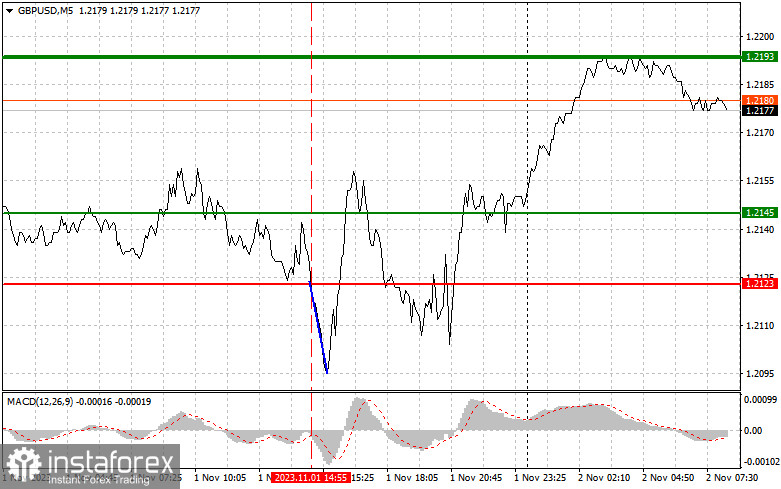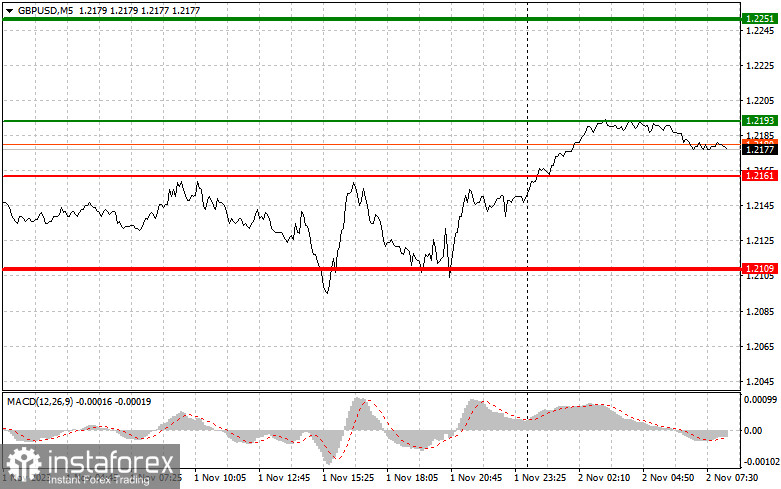Analysis of Trades and Trading Tips for the British Currency
The test of the price at 1.2123 in the afternoon coincided with the moment when the MACD indicator was just starting to move down from the zero mark, which generated a sell signal according to scenario #1. As a result, the pair was down by 30 pips. However, after the Federal Reserve's decision to leave interest rates unchanged and weak U.S. labor market data, the situation changed. Today, the pound may only have a chance to rise further once the Bank of England announces its interest rate decision. The decision should lean towards further inflation-fighting measures. During the speech, Bank of England Governor Andrew Bailey should also leave the door open for further rate hikes. If all of this doesn't happen, the pound will continue to rise against the U.S. dollar. Regarding the intraday strategy, I will act based on the realization of scenarios #1 and #2 for buying.

Buy Signal
Scenario #1: Today, you can buy the pound when the price reaches around 1.2193 (green line on the chart), with the goal of reaching 1.2251 (the thicker green line on the chart). I recommend exiting the market around 1.2251 and selling the pound in the opposite direction, targeting a 30-35 point move from the entry point. Pound growth can be expected in the first half of the day, in continuation of the uptrend, which may gain significant strength. Important! Before buying, make sure that the MACD indicator is above the zero level and has just started to rise from it.
Scenario #2: You can also buy the pound today if there are two consecutive tests of the price at 1.2161 while the MACD indicator is in the oversold area. This will limit the downward potential of the pair and lead to a market reversal upward. Expect an increase to the opposite levels of 1.2193 and 1.2251.
Sell Signal
Scenario #1: Selling the pound today can only be done after updating the 1.2161 level (red line on the chart), which will lead to a rapid decline in the pair. The key target for sellers will be 1.2109, where I recommend exiting short positions and opening longs in the opposite direction, targeting a 20–25 point move in the opposite direction from the level. Sellers may return at any moment, especially after failing to break above the daily high and in light of the Bank of England's uncertain position. Important! Before selling, make sure that the MACD indicator is below the zero level and has just started to decline from it.
Scenario #2: You can also sell the pound today if there are two consecutive tests of the price at 1.2193 while the MACD indicator is in the overbought zone. This will limit the upward potential of the pair and lead to a market reversal downward. Expect a decrease to the opposite levels of 1.2161 and 1.2109.

On the chart:
Thin green line – entry price for buying the trading instrument.
Thick green line – the expected price where you can set Take Profit or independently fix profits, as further growth beyond this level is unlikely.
Thin red line – entry price for selling the trading instrument.
Thick red line – the expected price where you can set Take Profit or independently fix profits, as further decline below this level is unlikely.
MACD indicator. When entering the market, it is important to consider the overbought and oversold zones.
Important. For novice traders in the forex market, it is essential to be very cautious when making entry decisions. It is best to stay out of the market before important fundamental reports are released to avoid getting caught in sharp price swings. If you decide to trade during news releases, always set stop orders to minimize losses. Without placing stop orders, you can quickly lose your entire deposit, especially if you are not using proper risk management and are trading with large volumes.
And remember that for successful trading, you need to have a clear trading plan, similar to the one presented above. Making spontaneous trading decisions based on the current market situation is initially a losing strategy for intraday traders.
 English
English 
 Русский
Русский Bahasa Indonesia
Bahasa Indonesia Bahasa Malay
Bahasa Malay ไทย
ไทย Español
Español Deutsch
Deutsch Български
Български Français
Français Tiếng Việt
Tiếng Việt 中文
中文 বাংলা
বাংলা हिन्दी
हिन्दी Čeština
Čeština Українська
Українська Română
Română

